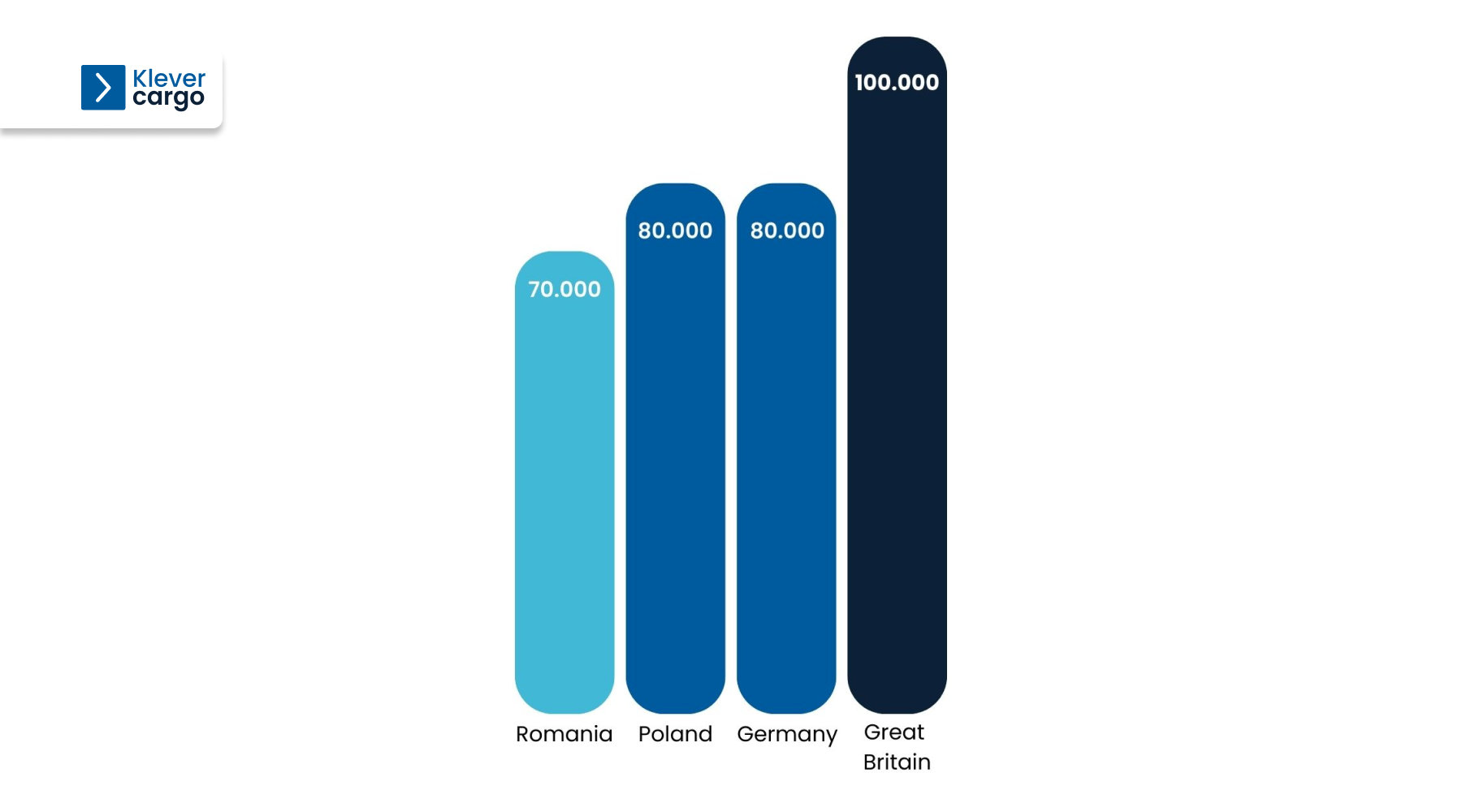The truck driver shortage is an issue that affects the transportation industry worldwide. The demand for goods and the need for efficient logistics operations continue to grow. Hence, the lack of qualified truck drivers poses significant challenges to supply chains.
This issue can gradually be solved with enough effort and innovative solutions over the next few years. Some countries already added some measures that showed excellent results. In the following words, we’ll explore what causes driver shortages and how to tackle this issue.
When did the truck driver shortage start?

Companies have been facing this issue for the past 15 years. The truck driver shortage across Europe started in the mid-2000s and became more severe in the 2010s.
At that point, tens of thousands of truck drivers needed to fulfil all the transportation needs. The rapid drop in available truck drivers was (and still is) a huge concern for freight companies.
Why is it such a big issue?
Truck drivers play a crucial role in the supply chain, supporting agriculture, manufacturing, and retail industries. Their absence would lead to fewer products on the market and higher prices. Their profession applies to both national and cross-border deliveries. Hence, their work has a massive impact on economic growth through trade and commerce.
Truck driver shortage in 2023
The truck driver shortage has been increasing over the years, with a shortage of 380,000 drivers in 2023. That sums up to 10% of total demand, and research shows that it could even reach 14% by the end of the year.
The trend is common for most European countries, and the situation isn’t much different across the globe. A few examples of countries with truck driver shortages are:

- Romania – 71,000;
- Poland – 80,000;
- Germany – 80,000;
- Great Britain – 100,000;
According to estimates, the shortage of truck drivers in Europe could reach two million by 2026. And since by that year, 30% of drivers will retire, the younger generations must fill in the gap.
However, there are 4-7 times fewer new drivers compared to the number that will retire in the next few years. Therefore, the priority is to tackle the root causes of the truck drivers’ lack and bring about substantial changes in the industry to address the problem.
What causes truck driver shortage?

The driver shortage is caused by factors like tough work conditions, strict rules to get a license, fewer people choosing the job, and changing preferences. These things make it harder to find enough qualified drivers, causing the shortage.
1. Lack of young truck drivers
There is a lack of truck drivers due to factors like the minimum age requirement, costs of training, and their perception of that career. The average age of a truck driver is over 50, with only 7% of drivers being under 25.
The European Union’s minimum age requirement for getting a commercial licence is 21. Numerous young people already choose their career path before that, which is a limitation for getting more young people into the industry.
The process of obtaining a driver’s license can be expensive due to training programs and certifications. Additionally, many young people are deterred from pursuing a career in truck driving due to the perception of low job security and demanding labour.
2. Working conditions
Truck drivers usually work long hours at an irregular schedule and spend much time away from home.
They can spend up to 56 hours on the road weekly and work up to ten hours daily. In addition, this career often requires working nights, weekends, and holidays. When you add to that physical labour (like loading and unloading cargo), many will say that being a truck driver is difficult.
3. Health and lifestyle challenges
Trucking requires you to sit for long periods by yourself. You’ll also face irregular sleep and unhealthy eating. Because of this, truck drivers face various health and lifestyle challenges.
Long sitting can cause health issues like obesity and cardiovascular problems. And since they’re usually alone in their trucks, that can lead to feeling isolated or depressed.
4. Strict licensing requirements

The training program for licensing can be lengthy, accompanied by age restrictions and high costs. Training, license fees, and medical tests are only a few factors that contribute to the price. Different countries have different costs, but these are rough estimates of how much you’ll invest to become a truck driver:
- United Kingdom – £1,500 to £3,000;
- Germany – €2,000 to €5,000;
- France – €1,500 to €3,000;
- Spain – €2,000 to €5,000;
- Italy – €1,500 to €3,000.
The prices will vary due to different training providers, duration, and any additional services you may need.
The exams are also known to be very strict. You’ll have to pass written tests, driving skill assessments, and knowledge of regulations. It can sometimes take months to complete all of that. In addition, the strict requirements may lead to a limited number of training programs. Because of that, some drivers can’t access training in their region.
5. Cross-border restrictions
Truck drivers move through multiple countries on their routes, so they face complex regulations and language barriers, which complicate things.
There is quite some documentation involved since cross-border trucking requires additional administrative tasks. There are certain permits and custom paperwork to comply with the rules of the country they are entering, particularly if the country isn’t in the EU.
That can also cause long waits at borders, especially if there is a language barrier.
Impact of the truck driver shortage

Truck driver shortage can significantly impact the supply chain and the economy. It’ll lead to problems like:
- delayed deliveries;
- increased transportation costs;
- higher product prices;
- safety concerns.
When there aren’t enough truck drivers to transport goods, delays can occur at distribution centres and warehouses. This can lead to problems such as stockouts and increased costs. Then, transportation costs rise to the point where companies must find other solutions to cover the expenses.
The truck driver shortage can also cause other types of issues. When there aren’t enough qualified drivers, the experienced ones may have to work overtime. That can lead to fatigue, which is very dangerous on the road. It can increase the risk of accidents and pose a threat to both the drivers themselves and other road users.
Finally, a driver shortage can also cause environmental issues. The trucking industry contributes to pollution and dirty air. The shortage of drivers can worsen this problem. It can lead to trucks taking longer routes and drivers not knowing how to drive in an environmentally friendly way. These things make pollution and its effects on the environment even worse.
Example of problematic truck driver shortage
The best example is the truck driver shortage in the UK in 2020. The COVID-19 pandemic caused panic buying and a huge increase in online orders. With that spike, companies had to restock their products quickly.
The UK already had a truck driver shortage even before the pandemic. And since the pandemic regulations became more fierce and some drovers caught the virus, it took a lot of work to keep up with the demand.
Companies tried to find solutions like hiring drivers from other sectors. However, they only managed to find temporary solutions, which weren’t enough to deliver all of the products. This entire situation led to massive shortages and drastic increases in freight prices. Naturally, that caused the prices of products to increase and deliveries to slow down, affecting the consumers as well.
This example highlighted how vulnerable the supply chain is. It also showcased that strategic planning and measures to attract and retain truck drivers are vital for the business.
How to overcome the truck driver shortage?

To solve the truck driver shortage, improving the job with good working conditions, higher pay, and chances to grow in the career is necessary. It should also be easier to become a driver by simplifying the rules and offering training programs.
-
Improving working conditions
Working as a truck driver is undoubtedly difficult. Hence, improving their wages and benefits is necessary to attract and keep drivers.
Their work-life balance is another thing that must be improved. Companies can do that by providing precise work schedules and offering more flexible working hours.
Truck drivers will likely encounter health issues, so companies should provide wellness programs and exercise facilities.
-
Attracting younger generations
Although this profession has its challenges, being a truck driver has various benefits. The wages are very competitive in larger companies, and career advancement options exist.
Companies should promote those benefits to younger generations and attract more potential candidates. The majority of young people enjoy travelling and exploring different places. That’s another great benefit they can enjoy in this career.
Another excellent idea is to promote those benefits in educational institutions. That way, the younger folks will understand that truck driving is a great career option at a younger age.
-
Simplifying licensing requirements
This is another crucial factor that would help with the truck driver shortage.
A good solution would be to streamline the application process. Digitalising that process would drastically speed things up.
Providing mentorship could also be very helpful. Companies should pair up experienced truck drivers with new recruits. That way, they can get all the tips and training on the job itself.
-
Technological advancements
Technology has become a central part of almost every business. Trucking should definitely adopt that trend.
They can do so with various apps, real-time data, and driver assistance systems. With those, companies could spot room for improvements more easily. It’ll also take some burden off of the drivers. With better communication systems, they would ensure a better flow of information between drivers, dispatchers, and customers. And with driver assistance systems, they would have more safety and less fatigue.
One of the ideal pieces of technology is the KleverCargo platform, where you can easily browse numerous offers and communicate directly with shippers. Plus, there is an option to automatically generate a CMR document, which saves you from the hassle of paperwork and reduces stress.
-
Facilitating cross-border operations
The mentioned cross-border restrictions are a large obstacle, constantly slowing drivers down.
To make things move faster, companies should collaborate with relevant authorities. And adding preclearance programs would be a great addition to solving this problem.
They should also include training for drivers who need experience with crossing borders. That includes customs and regulations, language and culture training, and the like.
Case studies and success stories regarding truck driver shortage

It’s clear that the trucking industry is facing some challenges and that they can be very harmful to the business. However, some countries found creative solutions for overcoming those obstacles.
-
Germany
Germany has an excellent internship system that includes training for aspiring truck drivers. This system provides structured training and on-the-job learning opportunities. This attracts younger individuals to the profession and addresses the driver shortage.
They also have recruitment campaigns to attract new drivers. They put a special focus on younger generations. These campaigns highlight the benefits of a career in trucking. It also points out the potential for professional growth and development.
-
United Kingdom
The UK has various driver training programs to enhance the skills of truck drivers. They focus on eco-driving techniques and safe driving practices to improve their performance. They also teach them efficient logistics operations to reduce environmental impact.
The UK government has also stepped up to collaborate with logistics providers. Some partnerships offer financial assistance to aspiring drivers.
-
The Netherlands
The Dutch highly value their work-life balance, and the truck driver career is no exception. They implemented regulations like rest breaks and limited driving hours. By doing so, truck drivers can have more time for themselves, thus reducing fatigue and improving job satisfaction.
They also added technological solutions like smart logistics. With the help of these, they can better optimise their routes and be more efficient on the road.
In summary

The truck driver shortage creates difficult challenges for the transportation industry. The obstacles drivers face can lead to delays, increased costs, and even safety issues. By improving their working conditions and adding more perks, they’ll attract more candidates for this position.
Of course, significant changes require time. Until then, you can always resort to other solutions, like a reliable platform to find available transportation offers. With it, you can minimise empty runs, find cargo for transportation and provide a better experience for your customers.


